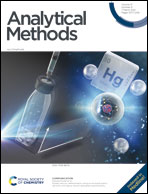Determination of multi pesticide residues in leaf and needle samples using a modified QuEChERS approach and gas chromatography-tandem mass spectrometry†
Abstract
In order to gain a better insight into pesticide and pollutant exposure in forests, a rapid and sensitive gas chromatography-tandem mass spectrometry (GC-MS/MS) method for the determination of 208 pesticide residues in leaves and needles has been established. The modified QuEChERS (quick, easy, cheap, effective, rugged and safe) approach uses 2 g of homogenized sample, acetonitrile and water as extraction agents, combined with citrate buffer for the following salting out step. The limits of quantification (LOQs) were determined to 0.0025–0.05 mg kg−1, respectively. Calibration curves showed a linear range between the respective LOQ and 1.0 mg kg−1 with coefficients of determination (R2) ≥ 0.99 for all analyzed pesticides. The recovery rates ranged from 69.7% to 92.0% with a relative standard deviation below 20%. The analysis of beech leaves, spruce and pine needles (each n = 3) provided a proof of concept for the developed methodology and revealed the presence of six pesticide residues (boscalid, epoxiconazole, fenpropimorph, lindane, terbuthylazine, terbuthylazine-desethyl). The results underline the strong need for systematic surveillance of the uncontrollable exposure of pesticides to nature.



 Please wait while we load your content...
Please wait while we load your content...